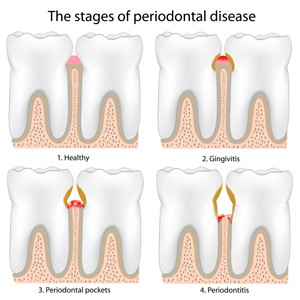The Stages Of Periodontal Disease
Periodontal disease, commonly referred to as gum disease, is an inflammatory disease that destroys the gums and other supporting structures around the teeth.
Periodontitis (gum disease) is not to be confused with gingivitis (gum inflammation). Gingivitis usually precedes periodontitis. However, it is important to know that not all gingivitis progresses to periodontitis.
In the early stage of gingivitis, bacteria in plaque build up, causing the gums to become inflamed and to easily bleed during tooth brushing. Although the gums may be irritated, the teeth are still firmly planted in their sockets. No irreversible bone or other tissue damage has occurred at this stage.
When gingivitis is left untreated, it can advance to periodontitis. In a person with periodontitis, the inner layer of the gum and bone pull away from the teeth and form pockets. These small spaces between teeth and gums collect debris and can become infected. The body’s immune system fights the bacteria as the plaque spreads and grows below the gum line.
Toxins or poisons — produced by the bacteria in plaque as well as the body’s “good” enzymes involved in fighting infections — start to break down the bone and connective tissue that hold teeth in place. As the disease progresses, the pockets deepen and more gum tissue and bone are destroyed. When this happens, teeth are no longer anchored in place, they become loose, and tooth loss occurs. Gum disease is the leading cause of tooth loss in adults.
Plaque accumulation due to poor oral care is the primary cause of periodontal disease. Other factors which can contribute to the disease are certain medical illnesses (diabetes and HIV infection), medications (dilantin and certain blood pressure medications), smoking, chewing tobacco and genetics (family history of oral disease).
What are the signs and symptoms of periodontal disease?
Gum disease may progress painlessly, producing few obvious signs.. Even if you don’t notice any symptoms, you may still have some degree of gum disease. In some people, gum disease may affect only certain teeth, such as the molars. Only a dentist or a periodontist can recognize and determine the progression of gum disease. Although the symptoms of periodontal disease often are subtle, there are some warning signs to be aware of:
- Gums that bleed during and after tooth brushing
- Red, swollen, or tender gums
- Persistent bad breath or bad taste in the mouth
- Receding gums
- Formation of deep pockets between teeth and gums
- Loose or shifting teeth
- Changes in the way teeth fit together upon biting down, or in the fit of partial dentures.
What is the treatment for periodontal disease?
For patients who present with the signs and symptoms of early periodontal disease, our dentists may recommend a “deep cleaning.” This procedure is called scaling, root planing and curettage. Scaling is the removal of tartar above the gum line. Root planing is a root surface debridement. Curettage is the removal of diseased soft tissue that abuts the root surface. The goal of scaling, root planing and curettage is pocket elimination. Most early cases respond to this treatment. In more advanced cases surgery may be indicated. Please refer to our patient education page for more information.


